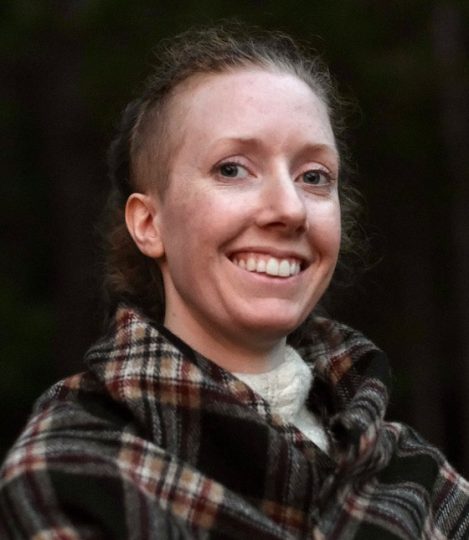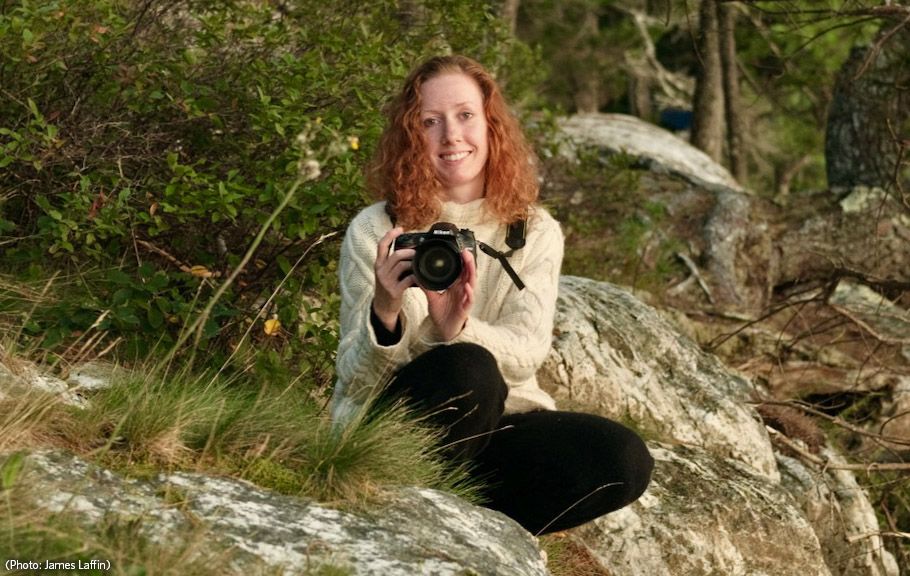In October, following the retirement of our long-time Events and Programs Coordinator Mikki Lane, the museum hired Caitlin Harder as her successor. As Caitlin begins her third month in the position, she sits down with Robert F. Reiff Curatorial Intern Annaliese Terlesky ’23.5 for some Q&A about her past experience and her hopes for things to come at Middlebury.
Can you tell us a little about your experience before arriving at Middlebury? Were you working in the art world leading up to working here?

I grew up just outside Middlebury, and originally left to study Studio Art and Art Theory at Marlboro College. I went on to earn my MFA in Sculpture and Dimensional Studies from Alfred University, and my MA in Cultural Management from Queen Margaret University in Scotland. As an artist, I’ve participated in many residencies over the years, and worked with other creative practitioners to develop a variety of artist collectives and exhibitions from the ground-up, usually in non-institutional settings. My postgraduate dissertation (which was a practice-based research project) explored the potential for alternative residency formats—such as pop-up/ micro/ virtual residencies—to further the cause of cultural democracy in the art world.
All of these experiences eventually led me to Yale University, where I served as Programs Manager at the Center for Collaborative Arts and Media. I returned to Vermont to be close to family during the pandemic, worked at the Co-op for a couple of years, and am thrilled to have finally ended up in my role at the Middlebury College Museum of Art!
I know that you’ve been involved in the process of selecting a new Curator of Collections and Director of Engagement for the museum. Can you speak a little about that process? What makes a good curator in your eyes?
We invited three finalists to campus over the course of a month for full-day interviews. During their visits, the candidates met with faculty, staff, and students in different settings, and led informal walk-throughs/ gallery talks in the Museum. As you can imagine, the month was a bit of a whirlwind! It was intriguing to hear each candidate’s unique vision for the museum’s future exhibitions, and their interpretation of the role of the curator within a small museum staff.
To me, a good curator is someone who is not afraid to experiment, collaborate, and play, who has a healthy relationship with the concept of failure, and who understands how to use art to spark conversations that feel relevant to audience members from a wide range of backgrounds and experience levels.
What else have you been involved in so far in your first few months here?
In addition to (a lot!) of general onboarding, my first few months have been focused on two key aspects of the Events and Programs Coordinator position. Firstly, I’ve been working on hiring, training, and supervising the museum’s receptionists, and co-supervising the Student Friends of the Art Museum (SFoAM) coordinators. Secondly, I’ve been liaising with members of the FoAM Board on various activities, including planning the 2023 Purchase Party and writing proposals for future events.
What do you look forward to working with the Museum? What events do you think the Museum is missing right now? What past events do you find the most engaging?
As an artist with a focus on site-specific installation, and a cultural manager, I’m very interested in the practice of collaborative “placemaking” as a strategy for developing and deepening relationships between arts institutions and their surrounding communities. More specifically, I’m intrigued by the existence of a museum as both a geographically-rooted place, and an imaginative space that can be quite flexible and expansive. Along those lines, I would love to explore the possibility of programming that activates places and spaces beyond the museum’s walls—outdoors, across campus, throughout the surrounding towns, or even within the digital realm—in ways that re-contextualize the museum’s collections and exhibitions.
This idea could take many forms. For example, a curatorial residency program that brings curators into local schools, where they work directly with students to develop collaborative pop-up or “time capsule” museums using objects that feel culturally significant to them. Or a residency program that invites contemporary artists to reimagine works from the Museum’s permanent collection for use in a mobile museum. Perhaps a program that pairs Studio Art and Museum Studies majors at Middlebury and challenges them to co-curate a themed exhibition in the MAC lobby or online. I could go on!
Probably unsurprisingly, the past events and programs that I find most engaging are those that have given participants first-hand experience and agency within the curatorial and programming process. Some examples are the MuseumWorks internship program, the Student FoAM Coordinator position, and FoAM’s “Art Club,” which meets for group conversations at the museum the second Sunday of each month.
What makes people visit and return to a museum? How do you think museums, especially someone in your position, can best engage an audience through art-related events and programs?
Especially in rural Vermont, I believe that people visit a museum to connect not only with their own community, but also with the broader world. Sometimes living in Addison County can feel like being in an isolated bubble, and a museum like ours offers exposure to different viewpoints, practices, and conversations that I think many people are incredibly hungry for.
I believe visitors return to a museum when they feel welcomed, directly engaged, and actively included in an ongoing cultural dialogue. In my opinion, the most effective way to engage an audience is by building opportunities for two-way conversation, reflection, and participation into the framework of each program and event—and by treating the programming process as a constantly evolving work-in-progress, which is responsive to the wants and needs of artists, curators, and audiences alike.
